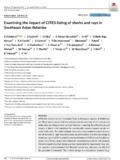Examining the impact of CITES listing of sharks and rays in Southeast Asian fisheries
นามธรรม
CITES (the Convention on International Trade in Endangered Species of Wild Fauna and Flora) aims to ensure that international trade in specimens of wild animals and plants does not threaten their survival. However, measuring the effectiveness and impacts of these trade regulations for commercially exploited aquatic species remains challenging. This study highlights observed or documented changes in elasmobranch fisheries in eight Southeast Asian countries before and after the listing of sharks and rays in CITES’ Appendix II, and the influence of CITES across five pillars or sectors of a “fishery assessment framework” developed especially for this purpose. Fisheries experts reported change was most common in the “governance” (e.g., policy, regulation and compliance) and “fisher(y)” sectors (e.g., structure and effort) of the assessment framework. The smallest change was recorded in “markets” (e.g., structures and prices) and “sociocultural” sectors (e.g., consumption, livelihoods and community awareness). Overall, the study demonstrates a measurable, albeit small, mostly positive influence of CITES in five of eight countries, while noting predominantly negative influences across two, and ongoing challenges for all in maintaining legal trade of these CITES‐listed species. The study concludes by offering guidance on future needs: most notably, more effort for long‐term collection of fundamental fisher‐, stock‐ and market‐related data to inform adaptive management and facilitation of legal trade where it is shown to be sustainable. Furthermore, as many of the shark and ray species under CITES provisions are transboundary stocks, increased support for communication and cooperation among regional fishery stakeholders is an ongoing need.
การอ้างอิง
Friedman, K., Gabriel, S., Abe, O., Adnan Nuruddin, A., Ali, A., Bidin Raja Hassan, R., ... & Ye, Y. (2018). Examining the impact of CITES listing of sharks and rays in Southeast Asian fisheries.Type
ArticleISSN
1467-2960; 1467-2979เรื่อง
คอลเลกชัน
- Journal Articles [11]

